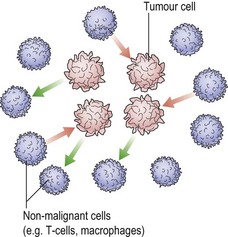51 The tumour microenvironment is currently thought to play a crucial role in cancer biology. A better understanding of the complex interactions between tumour and non-malignant cells is likely to translate into better characterization of tumour pathophysiology and novel approaches to therapy. In haematological malignancy, follicular lymphoma (see also p. 61) provides an excellent model for the study of the microenvironment. This disease accounts for approximately a quarter of all cases of non-Hodgkin’s lymphoma. Modern treatment with a combination of chemotherapy agents and the anti-CD20 monoclonal antibody rituximab has improved overall survival but cure is elusive. Better therapeutic strategies are needed. Technologies such as immunocytochemistry, functional cytotoxicity assays and 3-D confocal imaging have improved our understanding of the role of the microenvironment in this disease and offered the prospect of new treatments which tip the balance against the tumour cells. The various interactions are complex (Fig 51.1) but it is clear that CD8+ cytotoxic lymphocytes play an active role and have the potential to be employed in the treatment of follicular lymphoma. Most simplistically, a higher content of T-cells appears to confer a better prognosis while pro-tumour macrophages may worsen the outlook. Follicular lymphoma cells can manipulate the microenvironment to their own advantage. Stimulation of CD4+ T-cell cytokine release promotes tumour cell growth and survival. The tumour cells also employ mechanisms to block entry of cytotoxic T-cells into the tumour site and to inhibit recruitment and trafficking of previously healthy T-cells. The challenge is to find ways of supplementing current immunotherapy regimens (e.g. rituximab and chemotherapy) by tipping the balance in the tumour microenvironment towards enhanced T-cell anti-tumour activity and away from immunosuppression. Possible agents include immunomodulating drugs such as lenalidomide. Such considerations may also apply in other haematological malignancies. For instance, encouraging clinical results have been obtained in chronic lymphocytic leukaemia following the targeting of the tumour cells with genetically modified autologous T-cells. Fig 51.1 A schematic view of the microenvironment in follicular lymphoma.
Potential advances in treatment
Targeting the microenvironment in haematological malignancy

Cytotoxic CD8+ lymphocytes exert anti-tumour effects (red arrows) while tumour cells seek self-preservation (green arrows) by stimulating CD4+ T-cells to secrete favourable cytokines, inhibiting cytotoxic T-cells, and erecting a ‘tumour barrier’.
Oncohema Key
Fastest Oncology & Hematology Insight Engine



